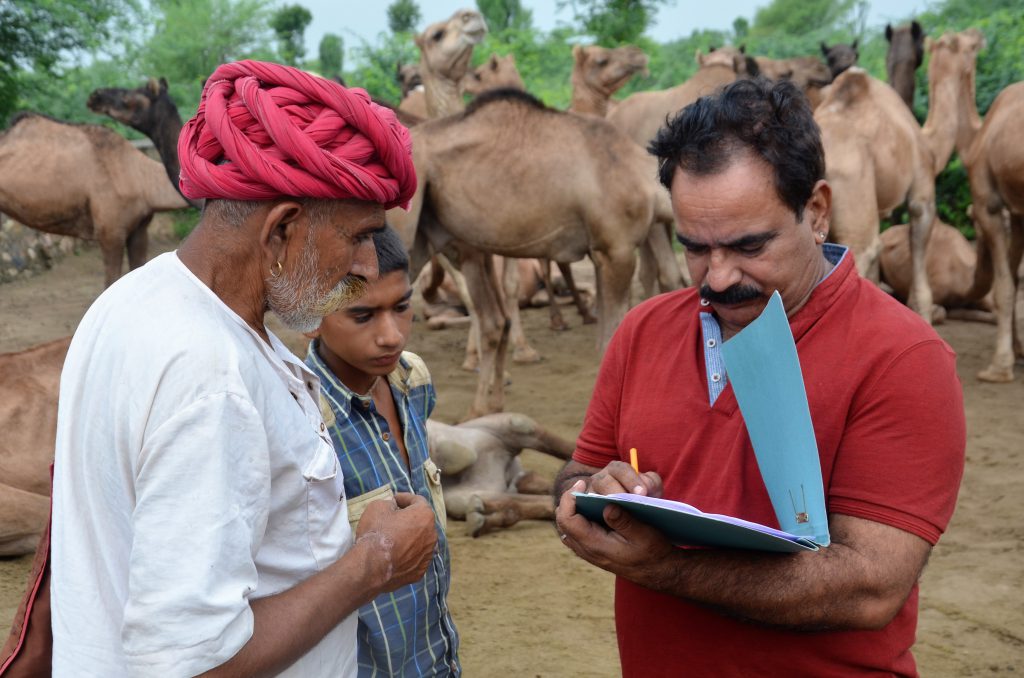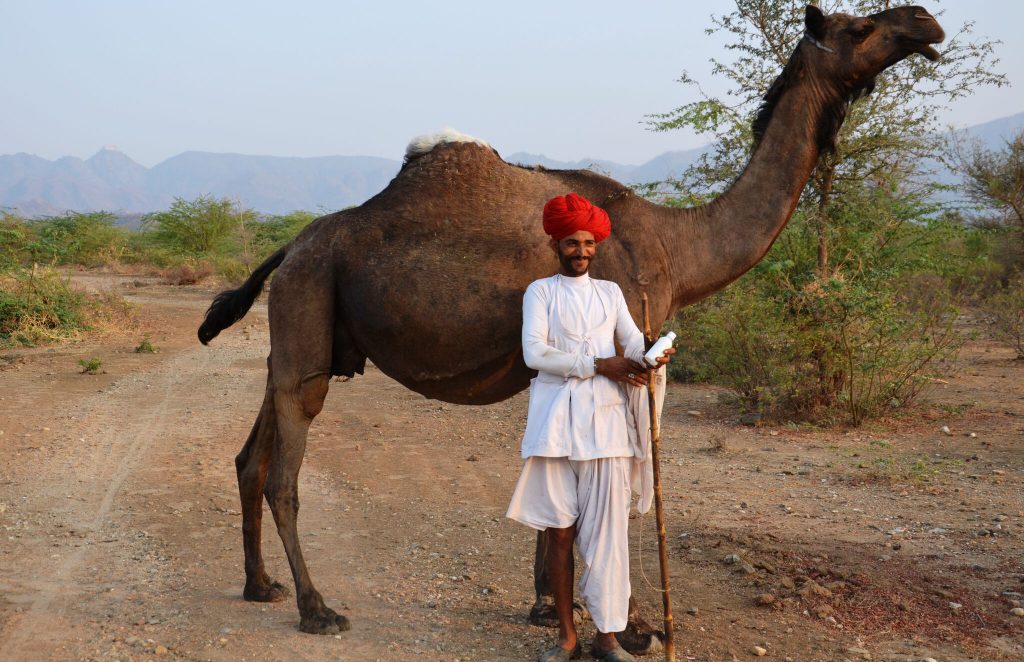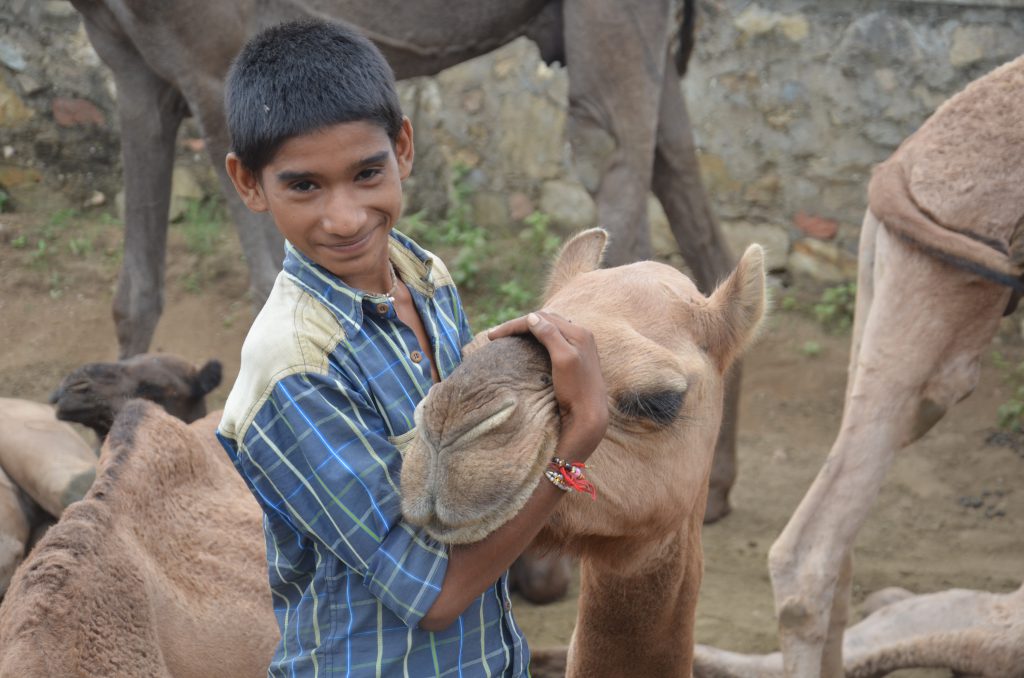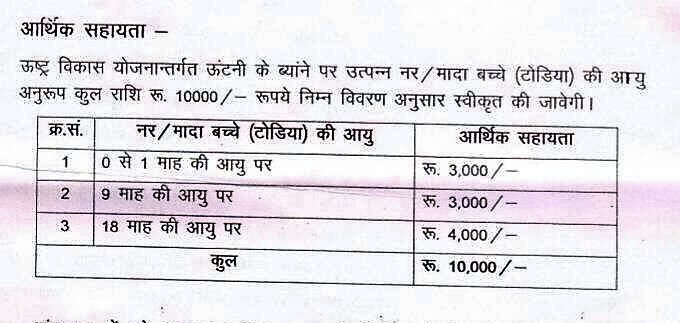
The news around camels in Rajasthan have been dismal over at least the last 15 years, with the population plummeting, the remaining camel herds suffering from neglect and no young people willing to enter the profession of camel herding. Declaring the camel state animal in 2014 and the passing of the Rajasthan Camel Bill (Prohibition of Slaughter and Regulation of Temporary Migration or Export) in 2015 only added to the gloom and certainly did not achieve the intended effect of reversing the fates of camels and their breeders.
But now there is some light on the horizon! Two developments make me feel that, if everything comes together, the situation can be turned around and Rajasthan’s camel economy revived. And maybe, maybe – I know this sounds highly ambitious – even a new model for ethical dairying developed: Milk production where the consumer knows where her milk comes from and is ensured that she purchases a pure and unadulterated product. Because you are what you eat, and it makes a difference whether your milk is produced by stall-fed animals fed on a diet of concentrate and milked for all their worth with the help of hormone injections or from animals that graze on biodiverse natural vegetation, let down their milk voluntarily and whose milk is “harvested” judiciously and with concern for the needs of the calves.
The first reason for my current optimism is that the demand for camel milk in India is on a steep rise, especially for the alleviation of autism and Diabetes. Camel milk has medicinal qualities for which consumers are willing to pay a premium and this creates a huge incentive for camel breeders to hang on to their herds or to even expand them. I have seen this happening in the last couple of months among the camel breeders that supply to the “Kumbhalgarh Camel Dairy” that is run by Camel Charisma and bridges the divide between urban camel milk consumers and camel breeders roaming around in remote areas.

But how to make sure the milk is from happy herded camels and not diluted cow or buffalo milk? Unfortunately there is still no field test available that can provide the answer. The only solution is to know exactly which herders the milk comes from and the number of milking camels they have. And to have the herders committed to provide genuine unadulterated camel milk and not a white fluid amalgamated from milk of other animals, water and other ingredients.
For this reason, Lokhit Pashu-Palak Sansthan (LPPS) is currently engaged in registering all camel herds in a 50 km radius from Sadri and educating the owners about the real opportunity for the survival of their camels and their own livelihoods if they commit themselves to providing a genuine product.
Meeting the herders is a humbling experience, seeing how the old Raika philosophy of “first the camels, then us” is still alive, the hardships and hard work they perform to keep their camels healthy, how many farmers appreciate the manure that the camels deposit on their fields as organic fertilizer, how closely the herdsmen observe nature and the effect of camel browsing on the trees of the Aravalli Hills. One can feel how camels are a crucial part of the agro-ecological web whose disappearance would undermine both local food production and ecology.
But most satisfying of all is to see how there are still young Raika keen to herd and look after camels if only it provides a decent income.

Diligent registration of herds is an absolute must for camel dairying to grow into an ethical and profitable business. Its also a must for the successful implementation of a just announced scheme by the Rajasthan government to provide a Rs 10,000 subsidy for all new camels born, in 3 instlments and over an 18 months period. This scheme can only succeed on the basis of proper herd registration, otherwise it will flounder and be abused as so often happens with well-intended schemes.

Both these developments – emergence of a market for a premium camel milk market and the subsidies for new-born camels – have the potential to provide a decisive boon to camel herders, both morally and financially. And if they would be embedded into a proper “Camel Policy” adopted and implemented by the Rajasthan, then we will be on the right track for conserving Rajasthan’s globally unique and ethical camel pastoralist system for the future!

 Follow
Follow
Now I see a silver lining in the clouds. A support of 10,000 IR/ newborn is a real and practical help. Is this payment will be allocated to each calf or only female calf?
Registration and mapping of the camel (in all aspect, like breed, type/purpose, region, herd composition etc) were my dream since years. The data national/state governments provide to FAO or other organizations are totally rubbish and hardly reliable. I really appreciate the LPPS effort to perform this task.
As you know camel is a mobile livestock so we have to find ways how to harvest from the mobile herds. Also centering camels at a point to take their milk has a negative effect on flora diversity of that region. I suggest if someone/organization provides them solar chillers and the milk is stored for 24 hours in chiller will be a great breakthrough.
In the meanwhile, you can keep finger crossing on the promotion of camel milk. It is not a very easy task to sell the milk at premium prices as the money really matters.
Thank you, Raziq, for your valuable comment. The 10,000 INR subsidy is for both male and female calves.
Yes, you hit the nail on the head. How to harvest from mobile herds? It can be done but requires investment in solar chillers, etc. Looking at the many ecological benefits of pastoralism over sedentary livestock keeping, this investment could be generated throiugh payment for ecological services. Seeing how emissions from agriculture are starting to get more attention now, it may not be too far-fetched to expect that such payments will eventually be forthcoming.
I am very happy to know this news.Incentives on Bio-Diversity Conservation is Great.
Again on matters of Camels, it is really a work of Gems by LPPS,Sadri, Rajasthan.
Let this spread others.
i am pleased to see this ,yes of course pastoralism is a sustainable way of life if they concern authorities can enhance it, women in isiolo kenya have benefited from camel milk
Dr Ilse has hit a nail on the head, when she highlights the simple fact that camel milk can be easily adulterated with cow or buffalo milk, just to ensure the higher price that the camel milk fetches.
This problem is not just for camel milk for the dairy sector itself in India where milk from cows, buffaloes, goats and camels are mixed, mixed and mixed and sold as “milk” to unsuspecting customers who either wanted milk sourced either from cows or buffaloes or goats or camels. Interestingly, even the FSSAI the regulatory authority in India does NOT specify that even the milk that is sold as cow or buffalo milk has to be sourced from cow or buffalo! All that it says that it should be a water based solution with a minimum % of milk fat and milk solids!! I am willing to be corrected here, if I am wrong in my reading of the Act and Rules.
If Dr Ilse thru LPPS succeeds in ensuring traceability of every drop of milk as camel milk, it would open up a new paradigm world of dairying in the entire World. I wish her and her team all the very best in the interest of dairy farmers specially in the developing world.
Thank you, Dr. Waran! We so much appreciate your help and inspiration!